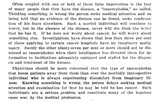Search Results
7/21/2025, 4:16:22 AM
Take the red pill from 1927
>Often coupled with one or both of these false impressions is the fear
of many people that they have the disease, a "cancerphobia,' so called.
Thinking something is wrong the person seeks medical attention and on
being told that no evidence of the disease can be found, seeks confirma-
Such a morbid individual will continue to
tion of his fears elsewhere.
worry, but in the absence of the disease, never will die from the belic/
that he has it. If he does not worry about cancer, he will worry about
something else. Investigations have shown that less than three per cent
of those applying to certain cancer hospitals have an imaginary malig-
nancy. Surely the other ninety-seven per cent or more should not be dis-
missed as cancerphobes when their intelligence has directed them for in-
formation to institutions adequately equipped and staffed for the diagno-
sis and treatment of the disease.
Physicians should be more concerned over the type of cancerphobia
that keeps patients away from them than over the morbidly introspective
individual who is always experiencing discomfort from imaginary ill-
ness. Knowing something is wrong, the person delays seeking medical
attention and examination for fear he may be told he has cancer. Such
individuals are a serious problem and constitute many of the hopeless
cases seer: by the medical profession.
>Often coupled with one or both of these false impressions is the fear
of many people that they have the disease, a "cancerphobia,' so called.
Thinking something is wrong the person seeks medical attention and on
being told that no evidence of the disease can be found, seeks confirma-
Such a morbid individual will continue to
tion of his fears elsewhere.
worry, but in the absence of the disease, never will die from the belic/
that he has it. If he does not worry about cancer, he will worry about
something else. Investigations have shown that less than three per cent
of those applying to certain cancer hospitals have an imaginary malig-
nancy. Surely the other ninety-seven per cent or more should not be dis-
missed as cancerphobes when their intelligence has directed them for in-
formation to institutions adequately equipped and staffed for the diagno-
sis and treatment of the disease.
Physicians should be more concerned over the type of cancerphobia
that keeps patients away from them than over the morbidly introspective
individual who is always experiencing discomfort from imaginary ill-
ness. Knowing something is wrong, the person delays seeking medical
attention and examination for fear he may be told he has cancer. Such
individuals are a serious problem and constitute many of the hopeless
cases seer: by the medical profession.
Page 1
